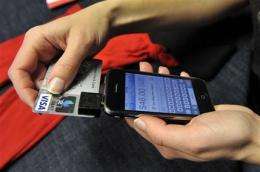Twitter co-founder takes aim at mobile payments

(AP) -- Jack Dorsey revolutionized online socializing by co-founding Twitter in 2006. Now he wants to transform the way people exchange money.
Dorsey is leading a new startup called Square. Its first product resembles a cube: a tiny credit card terminal that plugs into the headphone jack of an iPhone. The goal is to make it easier to complete a credit card transaction, whether you're a street vendor selling T-shirts or an individual settling a lunch tab with a friend.
Dorsey, who was Twitter's CEO until October 2008 and remains the social network's chairman, said he came up with the idea for Square nearly a year ago with Jim McKelvey, a glass artist who was frustrated after losing out on a $2,000 sale because he was unable to accept a credit card from a customer.
The two started brainstorming about how businesses and individuals could quickly start accepting credit, debit and prepaid cards over the iPhone and other small electronics, and came up with the idea for a credit card reader that connects to a cell phone.
Eventually, McKelvey and a group of engineers decided they should build a gizmo that hooks up to a standard audio jack, which is common on all sorts of consumer electronics from iPhones to BlackBerrys to laptops.
Many businesses already use eBay Inc.'s online payment system, PayPal, so that they can take plastic on their Web sites, and iPhone applications such as iSwipe and Credit Card Terminal are available for on-the-go transactions.
In January, electronic payment services company VeriFone Holdings Inc. plans to release a service similar to Square's. That service, PayWare Mobile, is aimed at small businesses and fits a credit card terminal and small stylus (for signatures) into an iPhone case.
A business often needs to have its own merchant account with a credit card company to use one of these methods, though. Square Inc. takes a different tack: It has its own merchant account, so it takes on the responsibility for minimizing risk and fraud, Dorsey said.
This also means that anyone can use the service.
"We're trying to build a utility that scales not just to someone selling coffee in a store but also someone selling their couch or buying a MacBook Pro on Craigslist," Dorsey said.
Using the so-called "square" is pretty simple. Swipe a card through a slit on its side, and the device will read your credit card number and convert it into an audio signal that can be sent to the iPhone through the audio jack. Software in the iPhone then decodes the signal and sends the transaction data out over the cell phone network to Square's servers so the purchase can be authorized. Information is encrypted on the iPhone before it gets sent.
Customers can sign for purchases by writing with a finger on the iPhone's touch screen. Once the transaction goes through, credit card information is deleted from the phone, Dorsey said.
Square also works with Apple Inc.'s iPod Touch, and Dorsey would like to soon have its software running on phones that use Google Inc.'s Android operating software, too.
Just about 100 of these squares are being tested by merchants in several cities across the country, and the company expects to release its first product to the general public in early 2010. It would give away the micro terminals and make money by charging transaction fees to those accepting payments. The fees have yet to be determined. Eventually Square hopes to offer a software-only option that doesn't require the plastic gadget.
Square could help people such as Willo O'Brien, a designer and illustrator who sells clothing, cards and jewelry on her Web site and at craft fairs. She used to leave fairs with a stack of credit card receipts she had to enter by hand on her computer. With Square, she swipes a customer's card and finishes the transaction on the spot, she said.
"The timesaving aspect of Square is huge," she said.
It has also made it easier for her to accept plastic anywhere she goes. O'Brien recently took some baby clothes to a local bar, where a friend picked out what he wanted for his daughter and swiped his credit card on her square.
Not everyone believes Square's approach is a good one, though. VeriFone CEO Douglas Bergeron said that encrypting data on the iPhone itself - instead of before the data is loaded to the device - presents a security risk. Beyond that, he's wary of Square's decision to have a merchant account for the company itself but not requiring individual businesses to have their own. Bergeron said VeriFone's offering will require merchants to have separate accounts.
"It would be like sharing bank accounts with your neighbor: It just doesn't work," he said.
But Tole Hart, an analyst for the Gartner Inc. research firm, believes Square could be right for street vendors and other small merchants. And because so many consumers are used to paying for things with credit and debit cards, Hart said, individuals might be interested in using it, too.
"It democratizes the receipt of credit card payments," he said.
©2009 The Associated Press. All rights reserved. This material may not be published, broadcast, rewritten or redistributed.





















